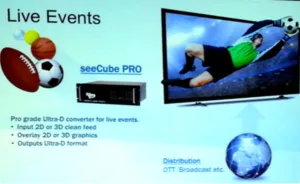We met with StreamTV at CES where the company told us about its progress in the manufacture of glasses-free 3DTVs and new initiatives in broadcast and gaming. At NAB, we had a chance to get another update from Duncan Humphries.
We started by taking a look at its 65” 3DTV. The company has done a good job of minimizing the transitions from zone to zone, but there is still a clear “waviness” that is apparent with moderate head movement. It doesn’t see this as an issue but I remain skeptical that this will be acceptable for most consumers. One look at this TV by my wife would mean it would never be looked at again, and I don’t think her reaction is all that unusual.
In addition, there remains a comfort zone for the TV. If you are too close it is painful to watch and from too far away you lose any sense of depth. At NAB, the best viewing appeared to be at about 15 feet (4.7m) away, but there was not a lot of apparent depth.
Nevertheless, the company continues to push forward with its partners. In May, it says its automated binding plant will start production, mating its proprietary optical layer to 4k LCD screens. Displays in 50”, 55” and 65” are planned with production of 150K units in 2015. In 2016, it will start mass production as five global brands have committed to buying product. Production of 28” and 32” screens is coming too, to support the gaming segment. Prototypes of tablets and smartphone exist too.
The displays can show accepted 2D content and convert to AS-3D or play as native HD or 4k content in 2D. It can also accept stereoscopic content to play in glasses-free 3D mode.
In the broadcast space, the company has a second generation processor called seeCube Pro. It can take in live 2D or stereo content and add in 2D or 3D graphics. The output is a 3D feed (in Ultra-D format) that plays on their displays. The mostly likely implementation appears to be to use 2D video with some graphics that have some 3D punch. They now have a plug-in for Nuke to help with content creation and Filemaker for streaming content. Humphries says sports federations seem to be the most interested in this capability as it allows them to create a new channel and revenue stream from existing assets.
Digital signage, the main original market segment for autostereoscopic 3D displays, is also doing well for the company. In fact, Humphries admits that nearly all of the 2015 production volume will go toward this market.
The firm is working with two CMS companies to help manage content on the screens. Inception Digital is doing quite well in this space having just ordered 100 screens for a test roll-out.
Humphries says sports stadiums are showing interest and a video wall product is in development for the end of 2015.
For the gaming market, the company has an SDK that works on Unity and Unreal game engines. This is aimed at developers for both console and PC-based game development, with monitors coming later to support end users.

